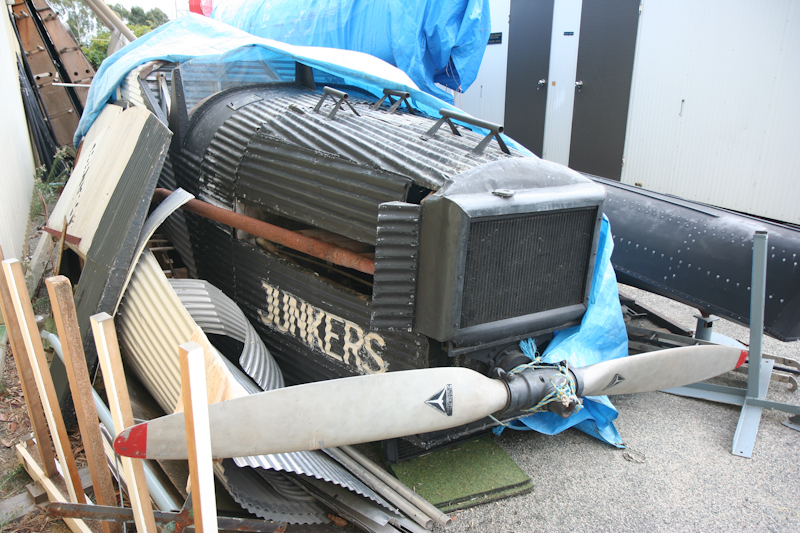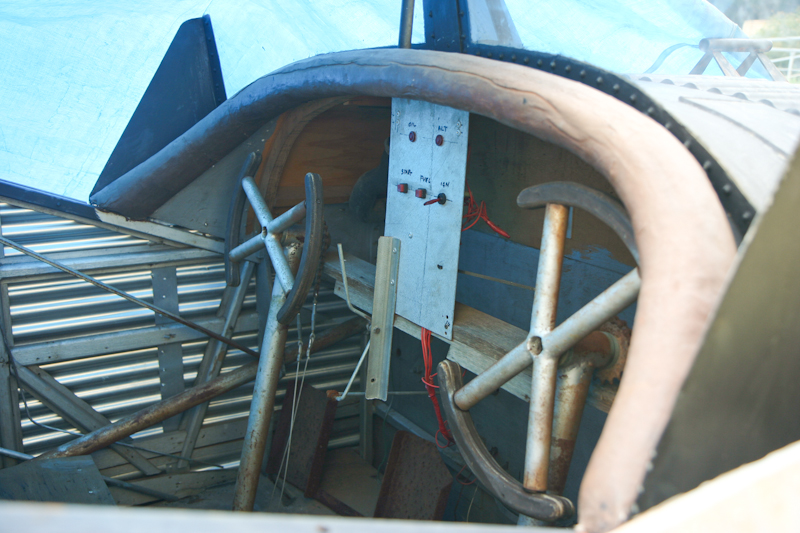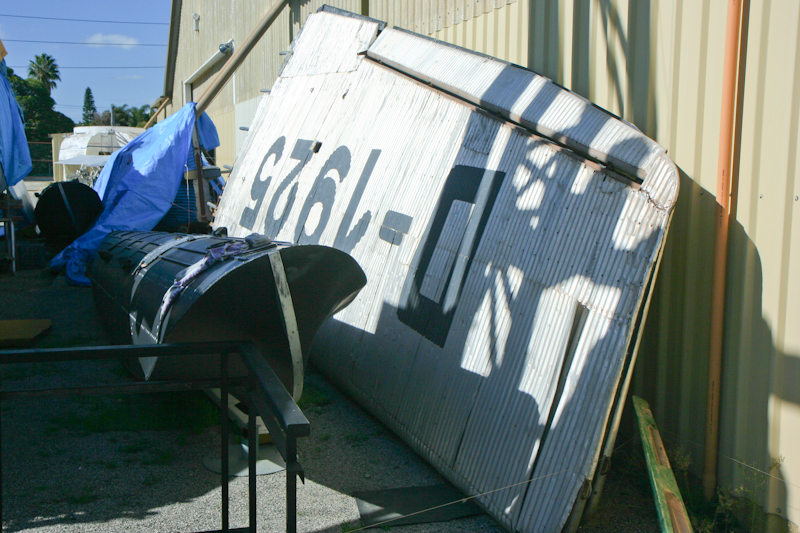SE-ABX |
|
|
| Early 1929: |
|
The aircraft was specially ordered from Junkers by Albin Ahrenberg for a flight across the Atlantic. It had a specially-tuned Junkers L5 engine, floats, and extra large fuel tanks giving an endurance of 7 hours. |
| 15 May 1929: |
|
Registered SE-ABX and named 'Sverige' (Sweden), owned by banking firm CG Cervin in Stockholm, Sweden. |
| |
|
|
| |
|
The transatlantic flight
was scheduled to go from Stockholm (Sweden) via Bergen (Norway), Faroe Islands, Iceland, Greenland and Labrador (Canada) to New York. |
| |
|
|
| 29 June 1929: |
|
The flight departed Bergen, Norway via the Faroe Islands. Following this, severe engine vibrations occurred, together with fuel and cooling system problems.
It reached Reykjavik on five cylinders with a loose propeller, cracked radiator and exhaust system. The engine-driven fuel pump had failed and only one of the hand-operated petrol pumps was operational.
A replacement Junker L5 engine was fitted at Reyjavik, and the aircraft continued its journey west across the Atlantic to Greenland.
En route to Greenland the aircraft ran into a powerful storm and thunder, so it landed at Ivigtut in southwestern Greenland to wait for better weather.
Whilst on the ground, the aircraft was damaged by a storm that broke one float and damaged an aileron and the rudder.
When this damage was repaired, Ahrenberg and telegraphist Ljunglund continued the flight from Ivigtut, heading to Labrador. However, during this flight, the aircraft suffered a lightning strike which damaged the radio and started a small fire. With only two hours of flying time remaining to Labrador, they were forced to return to Greenland.
In Greenland, the decision was made to abandon the trip, and the aircraft was disassembled and returned to Sweden by boat. |
| |
|
|
| 11 May 1930: |
|
SE-ABX was registered to new owner AB Aerotransport (ABA). |
| 15 Jul 1931: |
|
Cancelled from Swedish aircraft register
Registered D-1925 to Deutsche Lufthansa (on lease from ABA).
The aircraft operated a night mail route between Malmo and Hanover. |
| 31 Dec 1931: |
|
With the end of the lease to Lufthansa, D-1925 was cancelled from German aircraft register and again registered SE-ABX to AB Aerotransport in Sweden.
AB Aerotransport purchased a Junkers Ju-52/3m from
AB Flygindustri, and traded SE-ABX in as part payment. During its time at ABA, the aircraft flew 112,600 km spread over 662 flight hours.
AB Flygindustri refurbished the aircraft and sold it to Hans Bertram. |
| 21 Apr 1932: |
|
SE-ABX was cancelled from the Swedish register and again registered in Germany as D-1925 to Hans Bertram (leased from Junkers), and named "Atlantis". |
| |
|
|
| |
|
The aircraft was modified for a flight between Cologne (Germany) and Australia, a goodwill flight on behalf of Junkers Aircraft by Hans Bertram and Adolf Klausmann. |
| 14 May 1932: |
|
During the flight from Germany to Australia, whilst flying across the Timor Sea from Koepang, Netherlands East Indies (now Indonesia) to Darwin, a violent storm pushed them off course. They landed near Rocky Island, 160km from Wyndham, 480km west of their destination, with little fuel and water, and no food.
Having not been found by searchers, they took the aft end of a float from the aircraft to use as a boat, with a makeshift sail and rudder. |
| 27 May 1932: |
|
They sailed out to sea, and headed west. The currents and winds were strong, and they were exhausted in trying to make it to the shore. |
| 15 June 1932: |
|
Searchers found the Junkers aircraft on the beach with a note saying "27 May 1932. Australia. Today we left the plane in float as a boat in a westerly direction. Bertram." |
| 22 June 1932: |
|
Bertram and Klausmann were found close to death by some Aborigines, and kept alive for another week until a rescue party arrived. |
| 6 July 1932: |
|
They were taken to Wyndham on a boat and hospitalised. Bertram quickly recovered, but Klausmann's mental condition had deteriorated to a point from which he never fully recovered. |
| 19 July 1932: |
|
Bertram was flown by West Australian Airways to Perth, arriving on 19 July, and Klausmann was brought down the coast by the State Shipping Service vessel Koolinda. The search costed £361, which was paid by the Junkers company. |
| 18 Sep 1932: |
|
A fully-recovered Hans Bertram and Fred Sexton, a Western Australian Airways mechanic, returned to the aircraft with a replacement float from a De Havilland DH.50. It was smaller than the original but it served the purpose. |
| 24 Sep 1932: |
|
D-1925, repaired and with its engine serviced, was flown to Perth.
Despite the odd floats, the aircraft exhibited no unusual flying characteristics, but during take off Bertram had to carefully calculate the direction of the wind and tide as the port wing, the one with the smaller float, had a tendency to drop towards the water.
The aircraft landed on the Swan River, arriving on 24 September, less than a mile from the city centre. It was towed to the Royal Perth Yacht Club. |
| |
|
D-1925 was partially dismantled, and transported by road to Maylands Aerodrome, where it was fitted with a conventional landplane undercarriage by West Australian Airways (WAA).
Atlantis continued around Australia and back to Germany via the Netherlands East Indies. |
| 29 Sep 1932: |
|
At the end of the Perth-Kalgoorlie sector, on 29 September, Bertram made a very hard landing, wiping off the undercarriage and bending the propeller.
He phoned WAA for help, and they sent a mechanic to repair the aircraft. |
| 3 Oct 1932: |
|
D-1925 flew on to Adelaide and then round the eastern half of Australia, including a flight to Tasmania, and back to the Netherlands East Indies. |
| 3 Nov 1932: |
|
Klausmann, who had been unfit to fly back to Germany with Bertram on the Atlantis, had been sent back to Germany by ship. He arrived there on November 3, 1932. |
| 13 Dec 1932: |
|
Bertram had no other problems until he attempted to take off from Surabaya on December 13, 1932, when he ran off the end of the airfield and into a ditch, causing considerable damage to his aircraft. |
| |
|
Fortunately, Surabaya was a main Air Force and Navy base, and Atlantis was repaired with parts shipped from Germany |
| 11 Apr 1933: |
|
Following repairs, Bertram was able to continue his flight back to Germany. |
| 17 Apr 1933: |
|
Bertram arrived back in Berlin in the midst of an air display at Tempelhof Airport. |
| |
|
|
| |
|
The aircraft was later reregistered as D-OVYL. |
| |
|
|
| |
|
The cut off section of the float which had been used as a canoe had been abandoned where the two airmen had left it in 1932. |
| |
|
|
| 1975: |
|
The float was rediscovered on a field trip by the Western Australian Museum in 1975.
Brought back and preserved, it was initially put on display in the Fremantle Maritime Museum, but is now at the Aviation Heritage Museum, Bull Creek. |
| |
|
|
| |
|
More details and photos: click here. |

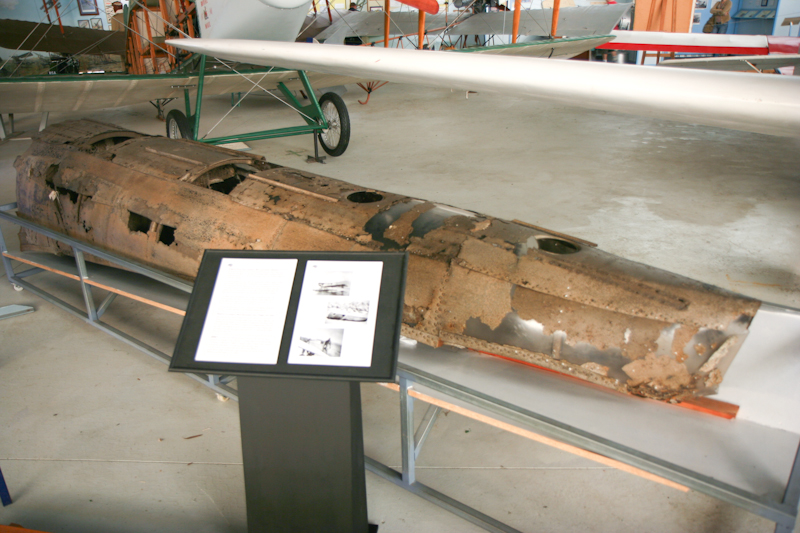
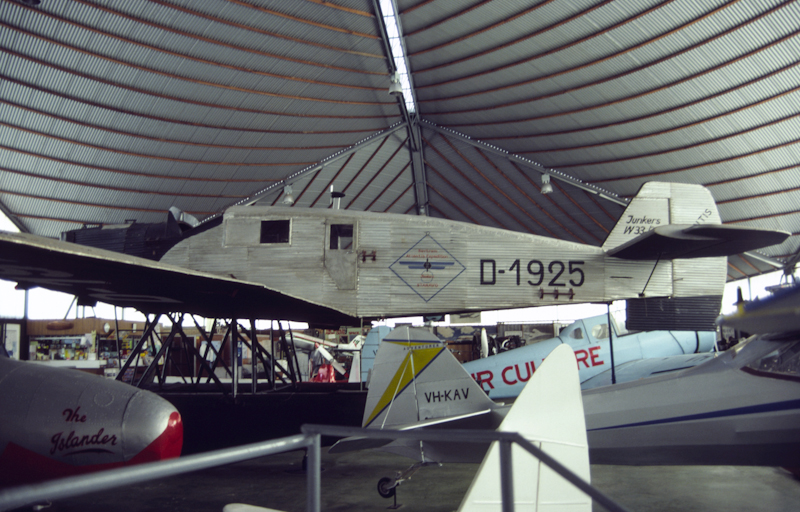 LEFT: "D-1925" "Atlantis" Junkers W33c replica built for the ABC TV series "Flight Into Hell", seen at the RAAFA Aviation Museum at Bull Creek on 10 October 1987. (Photos © David Eyre)
LEFT: "D-1925" "Atlantis" Junkers W33c replica built for the ABC TV series "Flight Into Hell", seen at the RAAFA Aviation Museum at Bull Creek on 10 October 1987. (Photos © David Eyre)